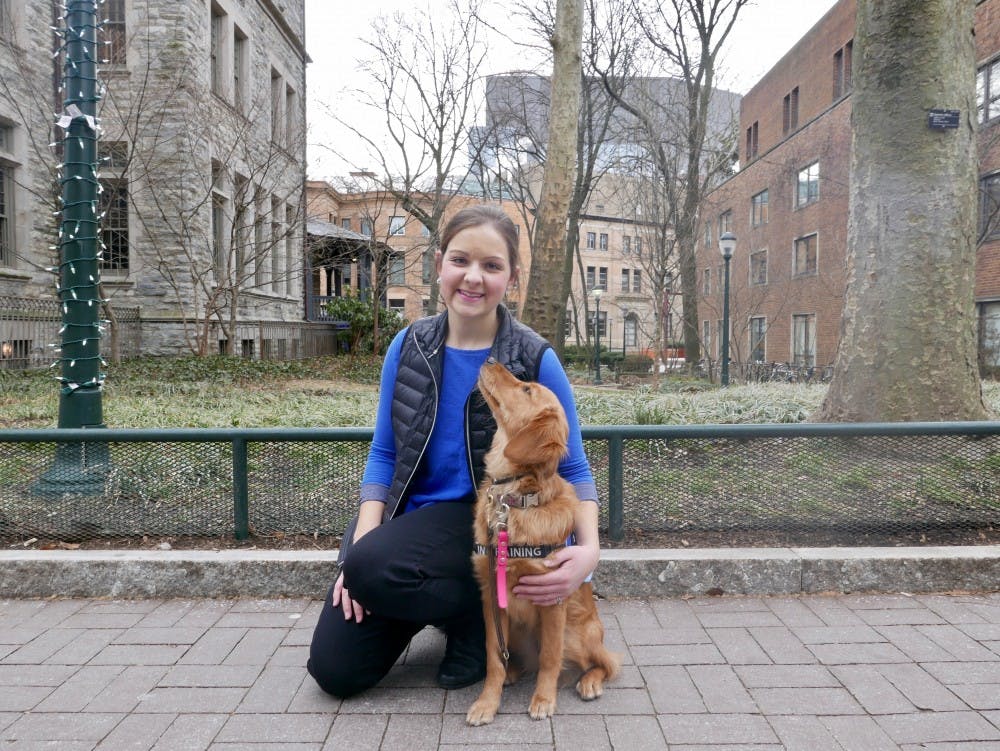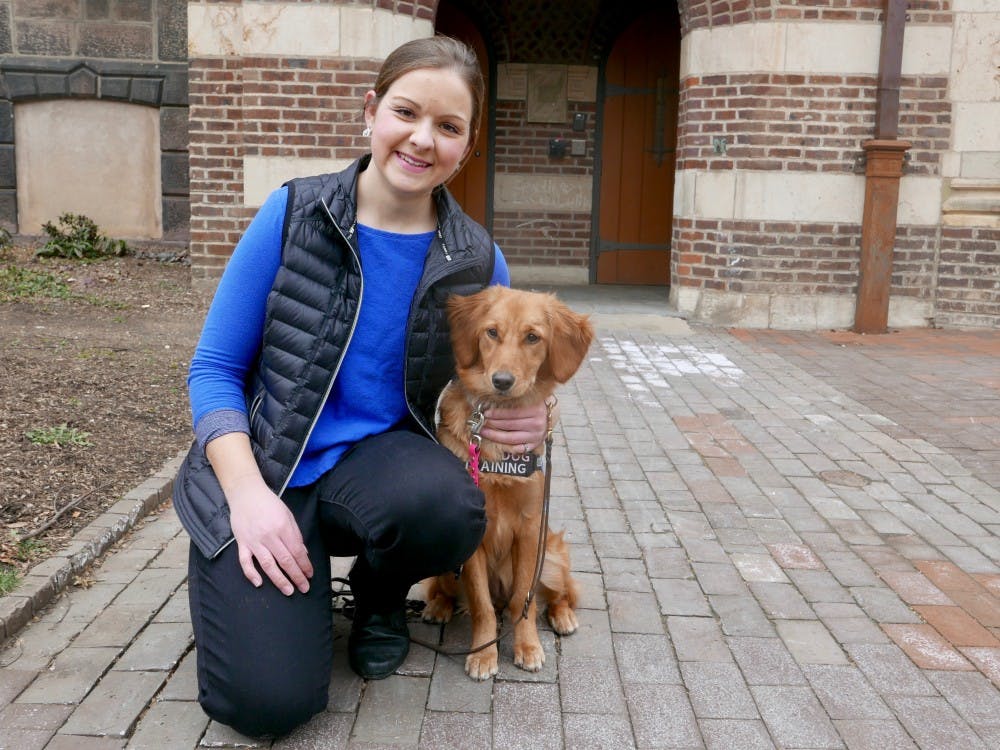Libby Rockaway (C ’19) immediately catches the attention of everyone around her as she walks about Penn's campus. No one can take their eyes off of her—or rather, her dog.
Libby has spent the last seven months of her college life with Franklyn by her side, a friendly miniature golden retriever sporting a blue “service dog in training” vest. She says it’s pretty normal for people to “just notice the dog and not the human,” but she doesn’t mind. Franklyn is adorable, and Libby, who is close to fully training her fifth service dog, is used to the attention.
Libby started working with dogs when she was eight years old. She boarded dogs in her home while their owners were outside of town, an experience which made her realize that “most dogs are really ill–behaved.” This inspired her to turn her boarding service into a dog–training service, which she called Libby's Loving Leashes, and in middle school, she worked with a professional breeder to train miniature golden retriever puppies.
In 2013, she started training her first diabetic alert dog, a dog that is specially trained to assist owners with type 1 diabetes. Libby’s friend was diagnosed with the disease, and she saw firsthand the daily difficulties that he faced as a child diabetic.
“This is really a beast of a disease,” she says. “You do these calculations for how much insulin you should have based on what you’re eating, but weather, stress, hormones, all these other factors come in. You can do the same exact thing two days in a row and have two different blood sugars.”
According to Libby, being unaware of your blood sugar level as a type 1 diabetic can be extremely dangerous. If your blood sugar is too low, it can result in insulin–shock.
People can’t always sense if their blood sugar is too high or too low. But, remarkably, dogs have an innate ability to smell blood sugar changes. Some dogs naturally react to blood sugar levels, often licking their owners incessantly when they sense a change, but any dog can be trained to alert their owners.
Today, Libby’s Loving Leashes specializes in training diabetic service dogs. According to Libby, training a dog from start to finish is an intensive, year–long process. At the very beginning, she works with a breeder to pick the right litter of puppies when they are five to six weeks old. This gives her the chance to look at the parents and get a sense of the dogs’ behaviors.
When the puppies are seven weeks old, she does a temperament test on her chosen litter, looking for traits that make dogs easily trainable. For example, she tests for persistence and food motivation by placing a treat under a container that the puppies can’t reach. The dog that simply won’t give up becomes a prime candidate for service.
Once she finds the right puppy, she starts obedience training right away.
“I teach [the dog] that the scent of low blood sugar is something that results in cookies,” she says, laughing. “For them, it’s not too complicated.”
Franklyn demonstrates the training process during our interview. Early on, she interrupts our conversation to tap Libby on the knee, her alert to check for high or low blood sugar. Libby pulls out a test strip, pricks her finger, and puts it into the reader. Franklyn has correctly sensed that her blood sugar is low, so Libby gives her a treat, which she munches on happily.

Libby shows me the tips of her fingers, which are poked with tiny holes. Although she doesn’t have diabetes, her blood sugar goes low often, which means that Franklyn alerts her up to 10 or 15 times day.
Franklyn is the third service dog Libby has trained while attending Penn. She says the experience of constantly having a dog–in–training has definitely shaped her college life. Franklyn is a “furry toddler,” and Libby is always thinking about things from her point of view.
Whenever she travels or does something new, she has to make sure that Franklyn feels safe to reinforce calm behavior. Whenever people try to get Franklyn’s attention (which happens often on a college campus), Libby has to teach her to keep her focus. The dog’s presence also affects her in sillier ways.
“I have dog treats everywhere in my life,” she says. “Every pocket, every crevice has dog treats.”
Although training a service dog in college is restrictive in some ways, Libby wouldn’t trade the experience for anything else. Franklyn is a “happy,” “goofy” dog, and Libby loves spending time with her.
“Every morning, she wakes up so ready to start the new day,” Libby says. “As soon as she sees that I’m awake, she’s up in my face, essentially saying, ‘Good morning! Let’s go outside! Let’s have breakfast!’ She’s also very good at her job.”
Libby loves to see her learn and grow, knowing that she’ll be helping someone in need very soon.
Franklyn, at nine months old, has been in training for seven months. At fourteen months, she will be fully trained for her new owner. For Libby, it is always hard to say goodbye.
She says that there are usually tears involved in the process, but she often falls in love with the families who end up taking her dogs. Before giving them over completely, Libby spends four to six months working with the families, allowing them to visit and get accustomed to dog training. She says she feels fulfilled to see her dogs making a difference in their lives.
“[Giving a dog up] is worth it the first time I get a text saying, ‘She gave an awesome alert tonight,’” she says. “Especially those times when they say, ‘I think she just saved my life.’ Those things are what make it 100 percent worth it, a million times over.”
After graduation, Libby will be without a dog for the first time in three years as she pursues a master’s degree in animal behavior in Scotland. Although she has to give Franklyn and her training up soon, she’s looking forward to starting up again when she returns.
“I’ll just be crying on the inside until then!” she says.
P.S. See adorable pictures of Franklyn on Penn’s campus on her Instagram, @llleashes!

